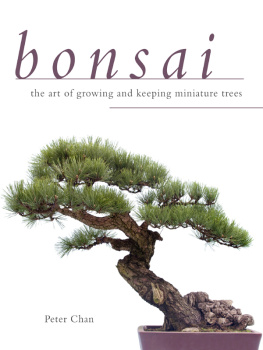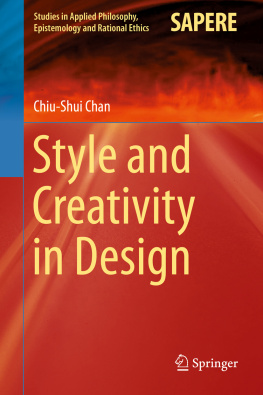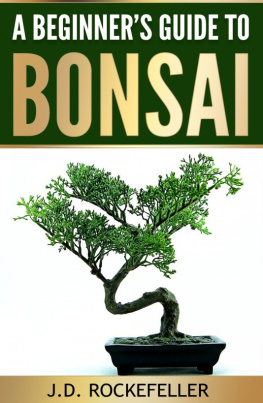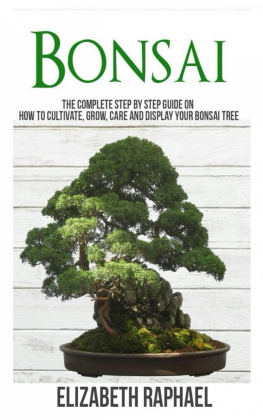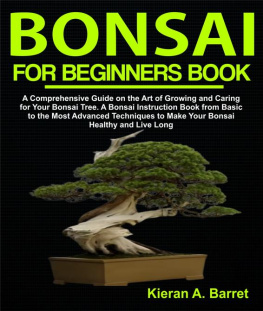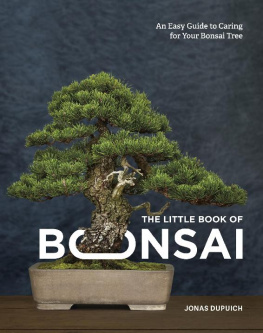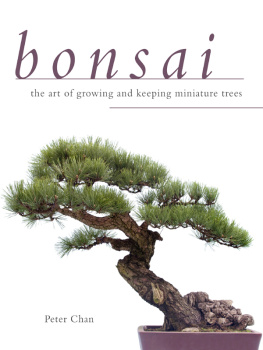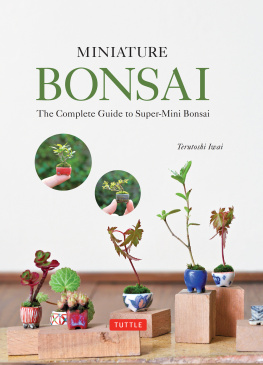Chan - Bonsai: the art of growing and keeping miniature trees
Here you can read online Chan - Bonsai: the art of growing and keeping miniature trees full text of the book (entire story) in english for free. Download pdf and epub, get meaning, cover and reviews about this ebook. City: New York, year: 2014, publisher: Skyhorse Publishing, genre: Children. Description of the work, (preface) as well as reviews are available. Best literature library LitArk.com created for fans of good reading and offers a wide selection of genres:
Romance novel
Science fiction
Adventure
Detective
Science
History
Home and family
Prose
Art
Politics
Computer
Non-fiction
Religion
Business
Children
Humor
Choose a favorite category and find really read worthwhile books. Enjoy immersion in the world of imagination, feel the emotions of the characters or learn something new for yourself, make an fascinating discovery.
Bonsai: the art of growing and keeping miniature trees: summary, description and annotation
We offer to read an annotation, description, summary or preface (depends on what the author of the book "Bonsai: the art of growing and keeping miniature trees" wrote himself). If you haven't found the necessary information about the book — write in the comments, we will try to find it.
Chan: author's other books
Who wrote Bonsai: the art of growing and keeping miniature trees? Find out the surname, the name of the author of the book and a list of all author's works by series.
Bonsai: the art of growing and keeping miniature trees — read online for free the complete book (whole text) full work
Below is the text of the book, divided by pages. System saving the place of the last page read, allows you to conveniently read the book "Bonsai: the art of growing and keeping miniature trees" online for free, without having to search again every time where you left off. Put a bookmark, and you can go to the page where you finished reading at any time.
Font size:
Interval:
Bookmark:



Copyright 1985 Quintet Publishing Ltd.
This edition printed in 2014 by Skyhorse Publishing, Inc.
All Rights Reserved. No part of this book may be reproduced in any manner without the express written consent of the publisher, except in the case of brief excerpts in critical reviews or articles. All inquiries should be addressed to Skyhorse Publishing, 307 West 36th Street, 11th Floor, New York, NY 10018.
Skyhorse Publishing books may be purchased in bulk at special discounts for sales promotion, corporate gifts, fund-raising, or educational purposes. Special editions can also be created to specifications. For details, contact the Special Sales Department, Skyhorse Publishing, 307 West 36th Street, 11th Floor, New York, NY 10018 or .
Skyhorse and Skyhorse Publishing are registered trademarks of Skyhorse Publishing, Inc. , a Delaware corporation.
This book produced by Quantum Publishing Ltd, 6 Blundell Street, London N7 9BH.
www.skyhorsepublishing.com
10 9 8 7 6 5 4 3 2 1
Library of Congress Cataloging-in-Publication Data is available on file.
ISBN: 978-1-62914-168-8
eISBN: 978-1-62914-262-3
Printed in China
CONTENTS













The two words bon sai, literally translated mean a potted tree. However, bonsai also denoies the cultivation of trees in pots. The characters are the same in both Chinese and Japanese.
CHAPTER 1
INTRODUCTION

What is bonsai?
Bonsai is simply the art and science of growing miniature trees and shrubs in decorative pots. And yet, there is so much mystique surrounding its practice that many people, including those with green fingers, are put off by what appears to be a very complicated and lengthy process. However, if one were to take the trouble to delve a little deeper one would soon discover that ordinary horticultural principles are involved and that bonsai is really no more than an extension of everyday gardening. The only difference is that the trees and pots have a particular aesthetic quality about them both as individuals in their own right and as ensembles.
Misconceptions about bonsai
As with all human endeavours, knowledge is the key that unlocks everything. This is as true of bonsai as it is of mathematics. Bonsai need not be shrouded in mystery, and the Japanese and Chinese need not have the monopoly of wisdom in this area. Because of the mystique which has grown up over the years around bonsai, many misconceptions and myths have gained credence. A common myth is that the practice of bonsai is cruel to trees. Those who think this imagine that the dwarfing process inflicts great pain on the tree. This widespread misconception has probably been fostered by memories of the ancient Chinese custom of foot binding in which the feet of young girls were prevented from growing by having tight bandaging from a very early age. This was indeed a cruel custom which has, of course, long been banned in China. However, people in the West still associate this practice with the dwarfing technique used in bonsai, for obvious reasons. Both processes restrict growth and somehow the dwarfing of trees by branch and root pruning is thought to be equally cruel. Of course anyone who is a gardener will know that branch and root pruning are an essential element in gardening. Roses, hedges, and even fruit trees need to be pruned from time to time. So with bonsai. Root pruning is necessary and is widely practised by gardeners and nurserymen the world over. Most gardeners will know that root pruning stimulates the development of fibrous roots. The undercutting of young trees and shrubs is standard horticultural practice and the development of containerized shrubs for the garden centre trade is a vivid example of why root pruning is so essential. Yet no one would argue that root and branch pruning as practised in the nursery trade is cruel to the shrubs and trees. The fact that bonsai live to a great old age suggests that they receive better treatment and care than their counterparts in the wild.

The accusation that bonsai is cruel to trees does not really hold.
Another even stranger misconception which has gained credence over the years is that a bonsai is first grown from seed planted in a grapefruit skin and that as the roots grow through the skin they are clipped or singed to keep the tree dwarfed. Again, nothing could be further from the truth. It is hard to imagine how a seed could develop into a tree in a grapefruit skin without the skin rotting and getting mouldy. No one knows how this particular myth developed but it is one which s often heard.
Bonsai defined
So far I have described only what a bonsai is not. But what is a bonsai? A bonsai, or miniature tree, has sometimes been described by cynics as an horticultural pygmy with delusions of grandeur. That may be so, but literally translated, the two Chinese words bonsai , which incidentally are the same in the Japanese language, mean a potted tree. However, merely having a tree in a pot does not necessarily make it a bonsai. A bonsai is an artistic replica of a natural tree in miniature form. It exists only in a pot or container. It is essentially a work of art and is produced by man through expert care and manipulation of natural plant material. It is above all a picture or illusion of a real tree.
An art form
Bonsai is an art form. Like any of the other visual arts such as painting or sculpture, it has all the essential aesthetic elements of composition, balance, perspective, depth, texture, colour and so on. The analogy of bonsai with painting in general and landscape painting in particular is especially appropriate. The objectives both in landscape painting and in bonsai are the same, in each case to create on a reduced scale what one observes in nature. Just as in painting, where one tries to reproduce on a small piece of canvas a vast panorama extending several kilometres or miles so in bonsai one seeks to create a miniature tree no more than a metre high from something which in nature would normally grow to 30 metres (100 ft) or more. In fact, there is a variant of bonsai practised by the Chinese called pen-jing or potted landscape. The Japanese equivalent of this is sai-kei or tray scenery. In this form of bonsai, the object is to create scenery with real live plant material in three-dimensional form.
Font size:
Interval:
Bookmark:
Similar books «Bonsai: the art of growing and keeping miniature trees»
Look at similar books to Bonsai: the art of growing and keeping miniature trees. We have selected literature similar in name and meaning in the hope of providing readers with more options to find new, interesting, not yet read works.
Discussion, reviews of the book Bonsai: the art of growing and keeping miniature trees and just readers' own opinions. Leave your comments, write what you think about the work, its meaning or the main characters. Specify what exactly you liked and what you didn't like, and why you think so.

